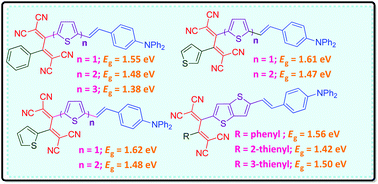New D–π-A push–pull chromophores as low band gap molecular semiconductors for organic small molecule solar cell applications†
Abstract
A series (10 examples) of thienyl spacing D–π-A push–pull chromophores end-capped with a triphenylamine (TPA) donor and tetracyanobutadiene (TCBD) acceptor have been synthesized in high yields. The synthesis of these chromophores as well as their synthetic precursors was accomplished in good to excellent chemical yields. Interestingly, acetylenic precursors displayed strong emissive properties with a large Stokes shift and positive solvatochromism behaviour. The photophysical investigation of the targeted chromophores revealed that their low optical band gap (ca. 1.38 to 1.62 eV) coupled with excellent molar absorptivity (ca. 28 800 to 90 500 M−1 cm−1) ensures good light-harvesting properties, while the electrochemical studies revealed their deep HOMO (ca. −5.31 to −5.16 eV) and LUMO (ca. −3.49 to −4.31 eV) energy levels suggesting them to be promising semiconducting materials for organic solar cell applications. An inverse bulk heterojunction (BHJ) photovoltaic device with a cell configuration of ITO/ZnO/BHJ/V2O5/Ag was fabricated to demonstrate the potential applications of these molecular semiconductors as active layer materials. A cursory analysis of the device performance of all materials under identical conditions showed a reasonable power conversion efficiency ranging from 1.95 to 3.33%. These initial results are encouraging for TPA-TCBD adjoined semiconductors with an indication of prospective applications and development, since their potential was little explored in small molecule-based organic solar cells.



 Please wait while we load your content...
Please wait while we load your content...